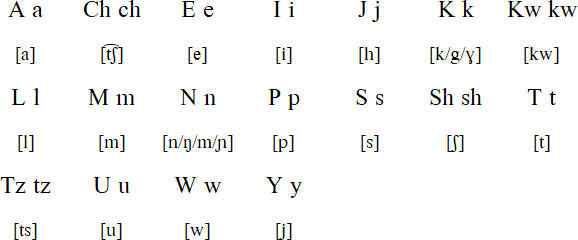Nawat is a Southern Uto-Aztecan language spoken mainly in western El Salvador, particularly in the departments of Sonsonate and Ahuachapán. Since the 1990s there have been various efforts to revive and revitalise the language, including the Nawat Language Recovery Initiative. Thanks to these grassroots movements, which receive no government support, the number of speakers of Nawat rose from about 200 in the 1980s to 3,000 in 2009.
Nawat is also known as Pipil or Nahuat. Nawat speakers call it Nāwat or Nāwataketsalis. It is a descendent of the Nahuatl spoken by Aztecs who fled from Mexico in 900 AD to escape persecution by Olmecs. Over time their language changed and is no longer mutually intelligible with Nahuatl. They settled in what would become El Salvador, Guatemala, Honduras, Nicaragua and Panama, though today their language is only spoken in El Salvador, having become extinct elsewhere.
There are several different ways to write Nawat. The one shown here is used by the Iniciativa de Recuperación del Idioma Nawat (IRIN).

Source: http://www.computing.dcu.ie/https://es.wikipedia.org/wiki/Idioma_pipil
Download an alphabet chart for Nawat (Excel)
Muchi ne tay gen tu weyga nestiwit tamagixti genga tik ekneliat wan ipal wan gichiwtiwit ipal ma munegigan ne se pal ne se.
All human beings are born free and equal in dignity and rights. They are endowed with reason and conscience and should act towards one another in a spirit of brotherhood.
(Article 1 of the Universal Declaration of Human Rights)
Information about Nawat | Numbers
Information about the Nawat language
http://www.native-languages.org/pipil.htm
http://en.wikipedia.org/wiki/Pipil_language
http://en.wikipedia.org/wiki/Pipil_language_%28typological_overview%29
http://en.wikipedia.org/wiki/Pipil_grammar
http://www.computing.dcu.ie/~mward/irin/index.htm
http://alanrking.info/nawatlanguage.php
Online Nawat lessons
http://www.computing.dcu.ie/~mward/nawat/general/html/intro_eng.html
Ne Bibliaj Tik Nawat (The Bible in Nawat)
http://nebibliaj.org/nawat-language.php
Comanche, Cora, Hopi, Huarijio, Huichol, Ivilyuat / Cahuilla, Kawaiisu, Luiseño, Mayo, Mono, O'odham, Nahuatl, Nahuatl (Eastern Huasteca), Nahuatl (Guerrero), Nahuatl (Tetelcingo), Nawat (Pipil), Northern Paiute, Serrano, Shoshone, Southern Paiute, Tarahumara, Tepehuán (Northern), Tepehuán (Southeastern), Tepehuán (Southwestern), Timbisha, Tongva, Yaqui
Languages written with the Latin alphabet
Page last modified: 10.05.24
[top]
You can support this site by Buying Me A Coffee, and if you like what you see on this page, you can use the buttons below to share it with people you know.

If you like this site and find it useful, you can support it by making a donation via PayPal or Patreon, or by contributing in other ways. Omniglot is how I make my living.
Note: all links on this site to Amazon.com, Amazon.co.uk
and Amazon.fr
are affiliate links. This means I earn a commission if you click on any of them and buy something. So by clicking on these links you can help to support this site.
[top]